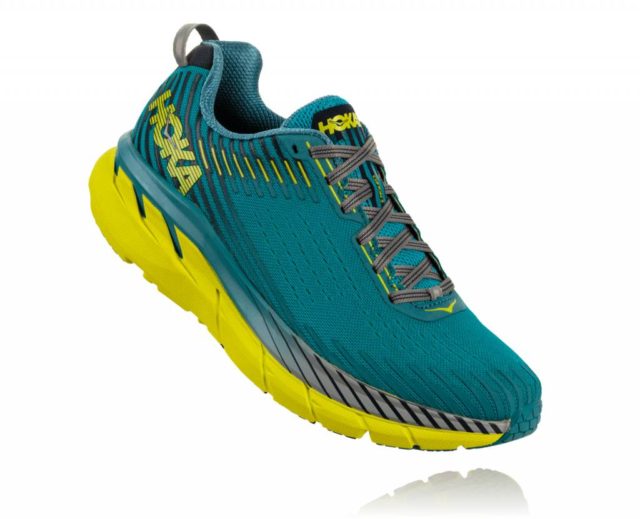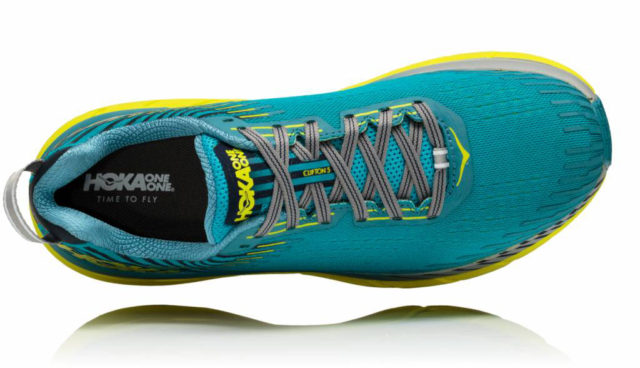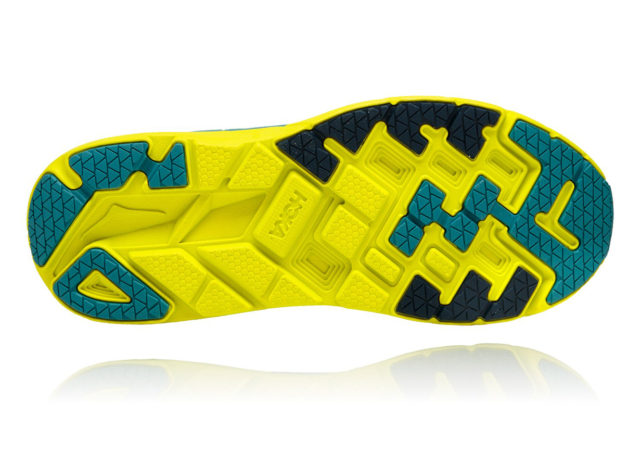
Hoka One One Clifton 5
Stack Height: 30 mm (heel); 25 mm (toe)
Drop: 5 mm
Stated Features:
- Engineered mesh upper with fewer overlays than previous versions to optimize breathability and comfort.
- Famed HOKA ONE ONE® midsole geometry and a trusted foam package to ensure consistent cushioning through the life of the shoe.
MSRP: $130
Size Tested: 10
Blister’s Measured Weight (size 10):
- Shoes + Laces (no insoles): 271 & 282 g
- Insoles: 24 & 24 g
- Total Weight: 295 & 306 g
Test Locations: Fort Collins & Denver, CO
Test Duration (So Far): 75 miles
Reviewer: 5’8”, 155 lbs. (my running background and preferences)
Intro
A few years ago, Hoka released the original Clifton, which was a radical departure from a lot of the other max-cushioned shoes that were storming the market at the time. The Clifton still had Hoka’s thick midsole, but it was also extremely light for how much cushioning it offered. And the original Clifton truly lived up to Hoka’s claims of its marshmallowy soft ride.
But over the years, the Clifton has evolved, and while some shoes maintain most of their predecessors’ “personality” or core traits through many new iterations, the Clifton has continued to move in a new direction, trading its low weight and plush midsole for more support.
I’ve been using maximalist shoes for several years now, and the original Clifton is still one of my all-time favorite road shoes. So I was eager to check out the newest iteration, the Clifton 5, to see how this latest version compares to the OG Clifton, as well as a few other highly cushioned shoes like the Altra Duo, Timp, & Olympus 3.0, and the Hoka Stinson ATR 4 & Speedgoat 2.
What Hoka says about the Clifton 5
“The Clifton 5 is the latest in the family of award-winning Clifton shoes. True to its heritage, the 5 is light, cushy and very, very fast. Central to its design is the famed HOKA ONE ONE® midsole geometry and a trusted foam package to ensure consistent cushioning through the life of the shoe. Combined with the forgiving and adaptive forefoot, we’re talking a smooth, smooth ride. The 5 also has a new engineered mesh upper with fewer overlays than previous versions to optimize breathability and comfort. We take new additions to the award-winning Clifton family seriously and we believe this upper really adds to the comfort, fit and feel for which the Clifton is known.”
So the main update for the Clifton 5 is the “engineered mesh upper,” which features fewer overlays than the Clifton 4’s upper. I’ll say more about the Clifton 5’s upper farther down, but the short story is that I’m a big fan.
The other thing that jumps out to me is this line: “True to its heritage, the 5 is light, cushy and very, very fast.” While the Clifton 5 may maintain some of those traits to an extent, I’d say the new shoe feels 5-generations separated from the original Clifton — i.e., it’s definitely changed over the years. And this is most obvious when it comes to weight.
Weight and Comparisons
First things first: given the size of its midsole, the Clifton 5 is not an obscenely heavy shoe. But take a look at the weight of the original Clifton. That was a truly light shoe. The original Clifton felt ludicrously light for how big it actually was.
So the Clifton 5 is not as crazy-light as fat racers like the OG Clifton and the new Altra Duo. But if you’re used to shoes with lots of cushioning (and the weight that often comes with their big midsoles) then I doubt you’ll find the Clifton 5 to feel excessively heavy. I pretty much always run in shoes with stack heights greater than 25 mm, and the Clifton 5’s weight hasn’t felt burdensome or annoying.
For reference, here are a few of our measured weights (per shoe, in grams) for some relevant shoes.
229 & 231 Hoka One One Clifton 1, size 10
252 & 255 Altra Duo, size 10
295 & 306 Hoka One One Clifton 5, size 10
297 & 297 Hoka One One Speedgoat 2, size 10
335 & 337 Altra Timp, size 10
333 & 348 Altra Olympus 3.0, size 10
333 & 357 Hoka One One Stinson ATR 4, size 10
Fit
As always, we highly recommend trying on any shoe before committing to it. That said, I’ll offer here some notes about how the Clifton 5 fits my feet.
For reference, I have pretty average-volume feet, but I have large lateral splats which mean my midfoot widens when weighted, and I therefore prefer shoes with more room in the midfoot. I also have a pretty flat arch, a low instep, and my toes taper in length with my pinky toe being much shorter than my big toe.

The Clifton 5 fits my foot pretty well overall. The heel feels very secure without feeling obtrusive or uncomfortable, and I haven’t had any major issues with heel lift.
The Clifton 5’s midfoot area feels pretty average compared to most shoes I’ve used, and maybe just a touch narrower than the original Clifton. Compared to the Hoka Stinson ATR 4, the Clifton 5 feels a bit wider through the midfoot, but narrower in the toe box as the Clifton 5 doesn’t widen much in the forefoot and tapers significantly in the toe box. I haven’t had any serious issues with my toes feeling cramped, but the Clifton 5 definitely has a much lower-volume toe box compared to any Altra shoes (e.g., Duo, Olympus 3.0, and Timp).
Like most shoes I’ve used, I experienced some midfoot pain in the Clifton 5 during my first few runs. But the upper broke in a bit, and I haven’t had any major pain since.
Upper
As I noted above, I like the Clifton 5’s upper. While the material around the heel and tongue is pretty thick and padded, the upper in the midfoot and forefoot of the shoe is fairly thin and has proven to be very breathable. The Clifton 5’s upper is not as minimal and airy as the uppers on the original Clifton or the Altra Duo, but for an everyday trainer shoe, I think the Clifton 5’s upper does a nice job of balancing low-ish weight and breathability with support and comfort.
I’ve never felt any hot spots while running in the Clifton 5, and I’ve never been wishing for more support while running on flat surfaces like pavement, packed trails, etc.
Midsole & Cushioning
For anyone who loved the original Clifton — or many of Hoka’s old, super-plush shoes for that matter — this is the big question: Does the Clifton 5 offer that soft, springy feel that Hoka shoes have become associated with?
Answer: Kind of.
On one hand, the Clifton 5 does feel a bit more plush and has more rebound than the Hoka Stinson ATR 4, and the Clifton 5 feels significantly more plush than the very-firm Altra Duo.
But I wouldn’t say the Clifton 5 feels particularly soft or pillowy compared to the whole running shoe market. The Altra Olympus 3.0 and Hoka Speedgoat 2 both feel softer and more bouncy, and the original Clifton feels like a trampoline compared to the Clifton 5.

But the key here is that a lot of people don’t want a super soft ride. And I think that’s probably a big reason behind Hoka’s move to firmer, less squishy midsoles across most of their line. Because while soft, heavily cushioned shoes can feel nice on casual runs, they can also be inefficient as you lose a bit of energy by sinking into the shoe.
And that’s what makes shoes like the Altra Duo so fast — that shoe’s firm midsole barely gives at all, meaning you get back most of the energy you put in.
The Clifton 5 isn’t quite as firm as the Duo, but the Clifton 5 does feel more efficient than the Altra Timp and Olympus 3.0. The Clifton 5 is pretty stiff both longitudinally and laterally, which equates to a pretty strong toe-off. The softer forefoot of the Clifton 5 does allow the shoe to flex a bit, but it’s still much stiffer than the original Clifton, Altra Olympus 3.0, Altra Timp, and Hoka Speedgoat 2.
So just because Hoka’s marketing campaign for the Clifton 5 centers around the words “soft” and features images of marshmallows, don’t be fooled — the Clifton 5 is not a super-soft, plush shoe. But it does slot nicely between very firm, race-oriented shoes like the Altra Duo, and squishier shoes like the Altra Olympus 3.0.

The Clifton 5 has a bit of rocker in the toe and heel, which helps it roll through each stride better than a similarly cushioned shoe with a flatter sole. The Clifton 5 isn’t as heavily rockered as the Stinson ATR 4 (which has an even thicker midsole), but the Clifton 5 has enough rocker to help combat its thick midsole and keep it from feeling very sluggish.
I tend to strike with my forefoot, and the Clifton 5 works fine for this style, with a fairly low heel-to-toe drop of 5 mm. That said, I think heel and midfoot strikers could also get along with the Clifton 5 since it has so much cushioning and the rockered sole helps it smoothly transition from heel to toe.
Outsole
The Clifton 5’s outsole is pretty minimal, with rubber reinforcements only in the high-wear areas around the edges of the forefoot, toe, and heel. It grips fine on dry, consistent surfaces like pavement and packed dirt, but when those surfaces got wet I was wishing for a bit more rubber as the Clifton 5 can get a bit slippery on wet terrain.

If you stick to dry, flat, consistent surfaces (i.e., what most people typically use a road shoe for), then I think the Clifton 5’s outsole will do just fine.
Durability
After around 75 miles, I don’t have anything major to report in terms of durability. The Clifton 5’s upper is in pristine condition, and shows very little wear. I don’t expect the Clifton 5’s partial-rubber outsole to hold up quite as well as shoes that feature more and / or firmer rubber, but so far, I don’t have any complaints in the durability department.
I’ll update this review if I notice any durability issues as I put more miles on the Clifton 5.
Who’s It For?
Compared to other similarly cushioned shoes, I think the Clifton 5 fits nicely in between minimal, firm, race-oriented shoes like the Altra Duo and softer, more forgiving options.

So if you’re looking for a road shoe with lots of cushioning but don’t want to go too far in either direction in terms of the how the cushioning feels (i.e., super firm or super soft), I think the Clifton 5 could be a good option. It feels fairly efficient, but still offers some of the slightly softer, more forgiving feel that many people look for in a highly cushioned shoe.
Bottom Line
The Hoka Clifton continues to evolve, and the new Clifton 5 could potentially make it a viable option for even more people than prior iterations. It’s not the softest or most springy shoe, but it still offers a bit of the forgiving ride that highly cushioned shoes are known for, while offering a bit more efficiency than the original Clifton.
